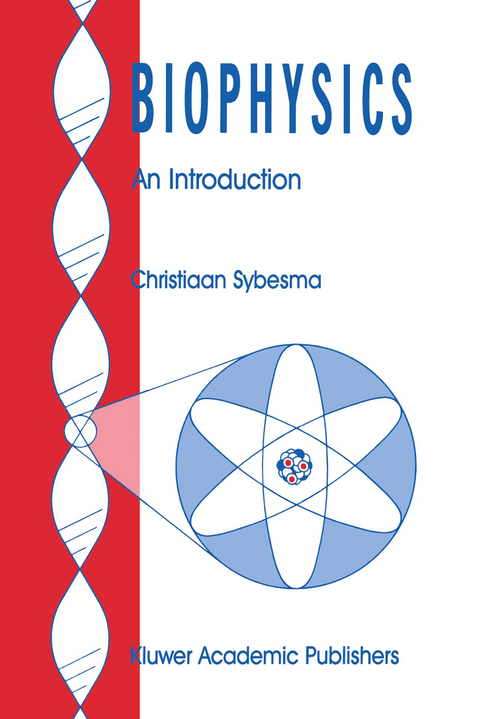
Biophysics
Springer (Verlag)
978-0-7923-0030-4 (ISBN)
Today, courses on biophysics are taught in almost all universities in the world, often in separate biophysics departments or divisions. This reflects the enormous growth of the field, even though the problem of its formal definition remains unsettled. In spite of this lack of definition, biophysics, which can be considered as an amalgamation of the biological and the physical sciences, is recognized as a major scientific activity that has led to spectacular developments in biology. It has increased our knowledge of biological systems to such an extent that even industrial and commercial interests are now beginning to put their stamps on biological research. A major part of these developments took place during the last two decades. Therefore, an introductory textbook on biophysics that was published a dozen years ago (c. Sybesma, An Introduction to Biophysics, Academic Press, 1977) no longer could fulfil " ... the need for a comprehensive but elementary textbook ... -" (R. Cammack, Nature 272 (1978), 96). However, because of the increased proliferation of biophysics into higher education, the need for introductory course texts on biophysics is stronger than ever. This fact, together with valuable comments of many readers, have encouraged me to revise the original book.
1. Introduction.- 1.1 What is biophysics.- 1.2 The fundamental principles of biology.- 2. Biological structures.- 2.1 The structures of life.- 2.2 The morphology of cells.- 2.3 The biological macromolecules.- 2.4 Membranes.- 2.5 Cell evolution.- 3. Physical principles and methods in biology.- 3.1 The electronic structure of atoms.- 3.2 The structure of molecules and molecular complexes.- 3.3 Absorption and emission spectroscopy.- 3.4 Infrared and Raman spectroscopy.- 3.5 Magnetic resonances.- 3.6 Size and shape of biological macromolecules.- 3.7 X-ray crystal structure analysis.- 4. Structure and function of proteins and nucleic acids.- 4.1 The structure of proteins.- 4.2 Enzymes.- 4.3 Recognition proteins.- 4.4 The genetic systyem.- 4.5 Regulation and control.- 4.6 Recombinant DNA.- 5. Biological energy conversion.- 5.1 The biological energy flow.- 5.2 Adenosine triphosphate in coupled reactions; pyridine nucleotides.- 5.3 Fermentation and glycolysis.- 5.4 The citric acid cycle.- 5.5 Respiration.- 6. Photosynthesis.- 6.1 Photosynthetic structures.- 6.2 Transfer and trapping of excitation energy.- 6.3 Photosynthetic electron transport in higher plants and algae.- 6.4 Photosynthetic electron transport in prokaryotes.- 6.5 Reaction centers.- 6.6 Carbon fixation.- 7. Biological transport processes.- 7.1 Passive and active transport.- 7.2 Osmotic equilibrium.- 7.3 Ionic equilibrium.- 7.4 Flow across membranes.- 7.5 Transport mechanisms.- 8. Membrane-bound energy transduction.- 8.1 The high-energy intermediate.- 8.2 The chemiosmotic model.- 8.3 Proton translocation.- 8.4 pH gradient and membrane potential.- 8.5 The proton-translocating ATPase.- 9. Biophysics of nerves.- 9.1 Nerves.- 9.2 The action potential.- 9.3 Synapses.- 9.4 Information processing in neuronal systems.- 10. Biophysics of contractility.- 10.1 Intracellular motion.- 10.2 Cellular motion.- 10.3 Muscular contraction.- 10.4 The energetics of contraction.- 11. Biophysics of sensory systems.- 11.1 The transmission of information.- 11.2 The visual receptor.- 11.3 The otic receptors.- 11.4 The chemical, somatic, and visceral receptors.- 12. Theoretical biology.- 12.1 Physical concepts and biology.- 12.2 Nonequilibrium thermodynamics.- 12.3 Modeling.- 12.4 Cybernetics.- 12.5 Generalizations in biology.- Appendix I. Some elements of quantum mechanics.- AI.1 The principle of quantization and the uncertainty principle.- Appendix II. Elements of equilibrium thermodynamics.- AII.l Definitions.- AII.2 First and second laws of thermodynamics.- AII.3 Entropy.- AII.4 Thermodynamic potentials.- AII.5 The chemical and the electrochemical potentials.- AII.6 The standard free energy of a chemical reaction.- AII.7 Oxidation-reduction potentials.
| Erscheint lt. Verlag | 31.7.1989 |
|---|---|
| Zusatzinfo | X, 320 p. |
| Verlagsort | Dordrecht |
| Sprache | englisch |
| Maße | 155 x 235 mm |
| Themenwelt | Naturwissenschaften ► Biologie ► Biochemie |
| Naturwissenschaften ► Chemie ► Physikalische Chemie | |
| Naturwissenschaften ► Physik / Astronomie ► Angewandte Physik | |
| ISBN-10 | 0-7923-0030-0 / 0792300300 |
| ISBN-13 | 978-0-7923-0030-4 / 9780792300304 |
| Zustand | Neuware |
| Haben Sie eine Frage zum Produkt? |
aus dem Bereich


